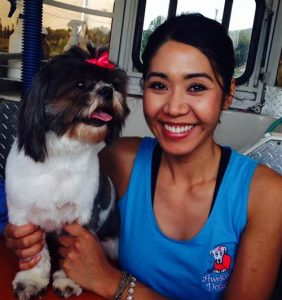Trimming Your Dogs Nails (Why & How)
 A dog’s nails need to be kept short in order for the animal to remain healthy. Overgrown and ingrown nails are painful for your pooch, and in extreme cases, can distort their posture, or curve around and grow into their paw pads, leading to serious infection.
A dog’s nails need to be kept short in order for the animal to remain healthy. Overgrown and ingrown nails are painful for your pooch, and in extreme cases, can distort their posture, or curve around and grow into their paw pads, leading to serious infection.
Many dogs do not like getting their nails clipped, and many dog owners have an aversion to wielding those scary looking clippers. The good news is that many dogs wear down their nails naturally, and don’t need us to trim their nails often if at all. If your dog walks on concrete surfaces daily, there is a good chance they may fall in this happy category.
How Long is Too Long?
If the tips of your dog’s nails touch the floor when they stand normally, it’s a good bet those nails could stand a trim. Some dogs do not mind getting their nails clipped, and will wait patiently. Others become frantic, especially if they’ve had a bad experience in the past. It’s your job (and ours, as professional groomers) to make nail trimming a positive experience. Nail clipping does not need to be traumatic for the dog or the person doing it.
The Right Tool for the Job
Start by having the right type of clipper for dog nails. One of the most efficient tools is the guillotine clipper, which features a blade that slices off the nail with the slide of a button. The other common style is known as a scissors clipper and works with the familiar scissors action. Use whichever style is more comfortable in your hand, but be sure they are sharp. If you have an old pair of clippers in the garage, throw them out and get a new pair. Definitely save your money and avoid those gimmicky tools “as seen on tv” that promise miracle results. If they really worked all that well, then professional groomers & vets would be using them!
How To Do It Right
Hold the clippers with the handles perpendicular to the floor. The blade should be facing away from the dog. In general, you want to cut off a maximum of half an inch per nail, but that varies depending on how long the nails are to start with. More important than the amount that you take off is to be careful to avoid cutting the “quick.” The quick is live tissue that contains nerve endings. If you cut into the quick, it hurts, and the dog’s nails will bleed – it’s like trimming your fingernails too short. The quick can usually be seen as a dark line on white claws. You can’t see the quick on dark claws. When you can’t see quick, the best practice is to gradually trim off small amounts of nail, checking the end of the nail after each clip. When you see a small dot appear in the middle of the freshly cut surface (when viewing the nail end-on), that’s the beginning of the quick, and it’s time to stop trimming.
A Few Final Tips
• Front feet often need to be trimmed more than back feet, so if you find yourself taking a lot off the front, don’t assume the same amount will need to come off the back.
• Don’t forget to trim the dewclaws (those extra nails that are half way up the legs on the inside).
• If you are sensitive to scratches, any rough edges left by the clippers can be sanded smooth using a metal nail file (recommended) or alternately, a fine textured dremel. Dremels take some getting used to, so these tools are not for beginners.

Overcoming Fear Takes Time
If your dog has been traumatized by nail clipping gone wrong in the past, keep in mind that their fear and panic is not going to go away overnight. It takes time and compassion, but it is possible to replace bad memories with good ones. We have many happy stories of pups who used to scream (really!) and panic when the nail clippers came out, that now cooperate calmly during nail clips. If the panic reaction is a common occurrence at your house, please consult with your groomer and get your pooch on the road to a more relaxed puppy pedicure.
For More Help
Our groomer Laura will be available for Q&A on nail clipping at the Yorkie Lover’s Meetup at the Rancho Bernardo dog park on September 30th. Or ask your regular groomer at your next appointment.
